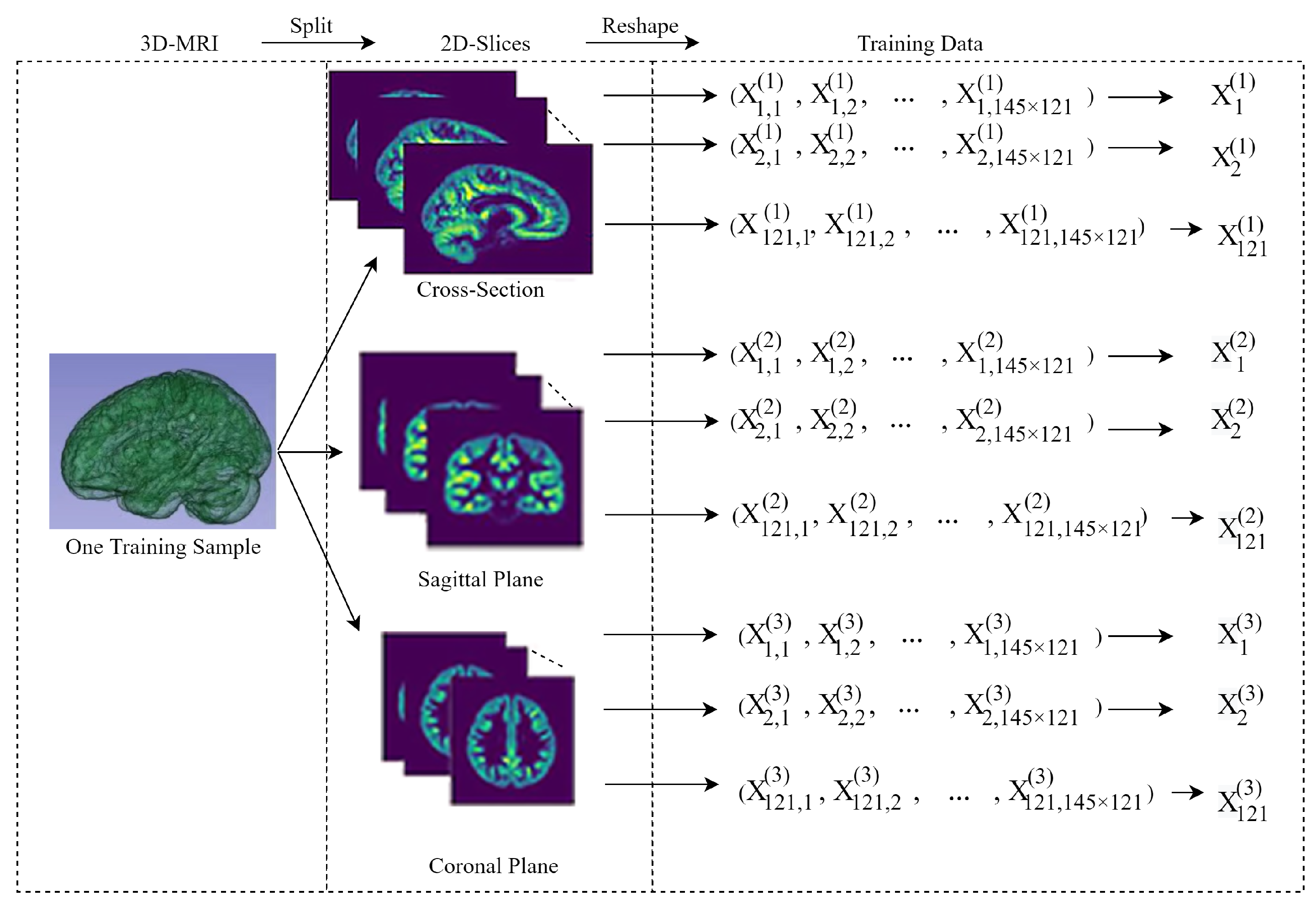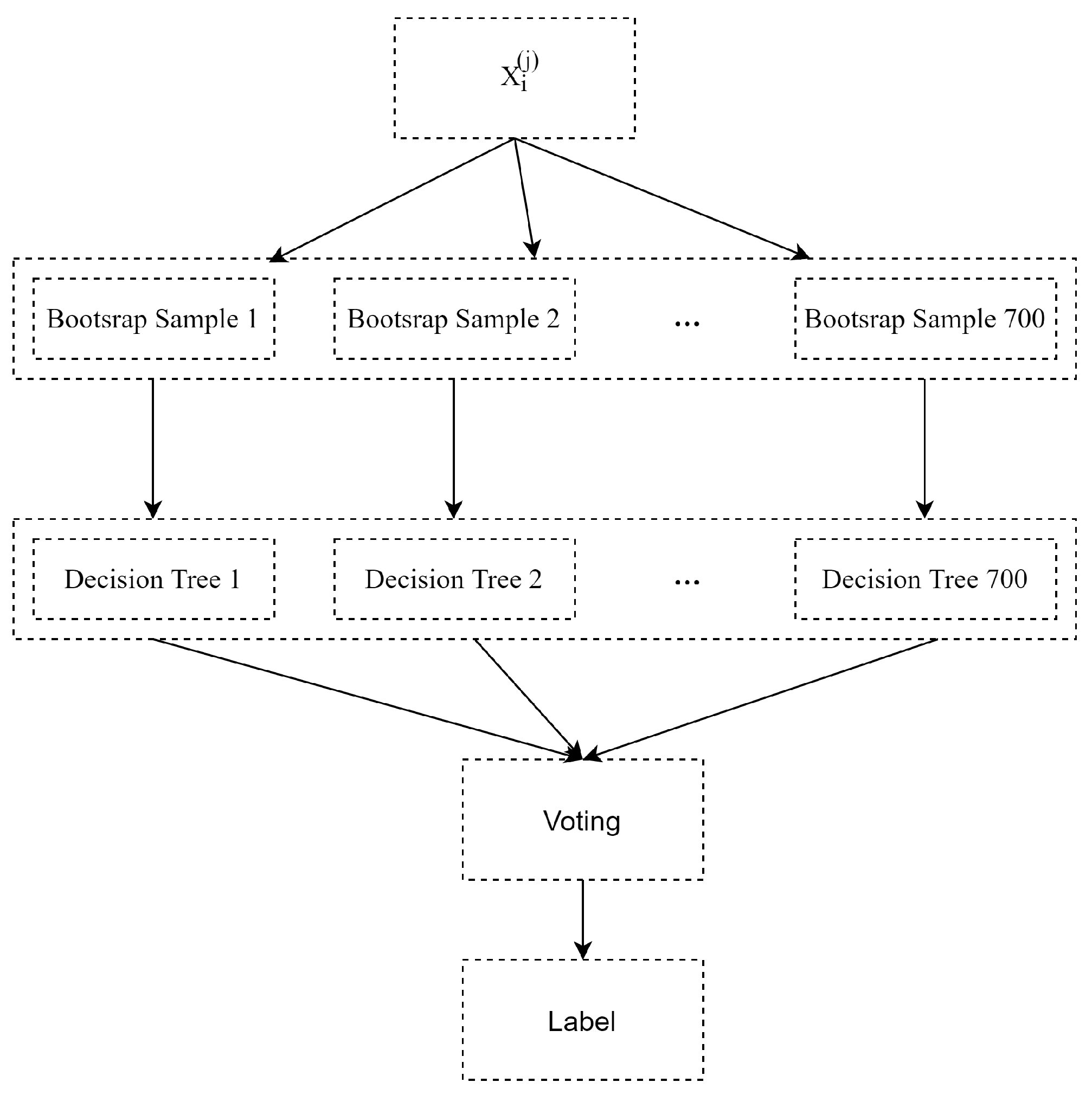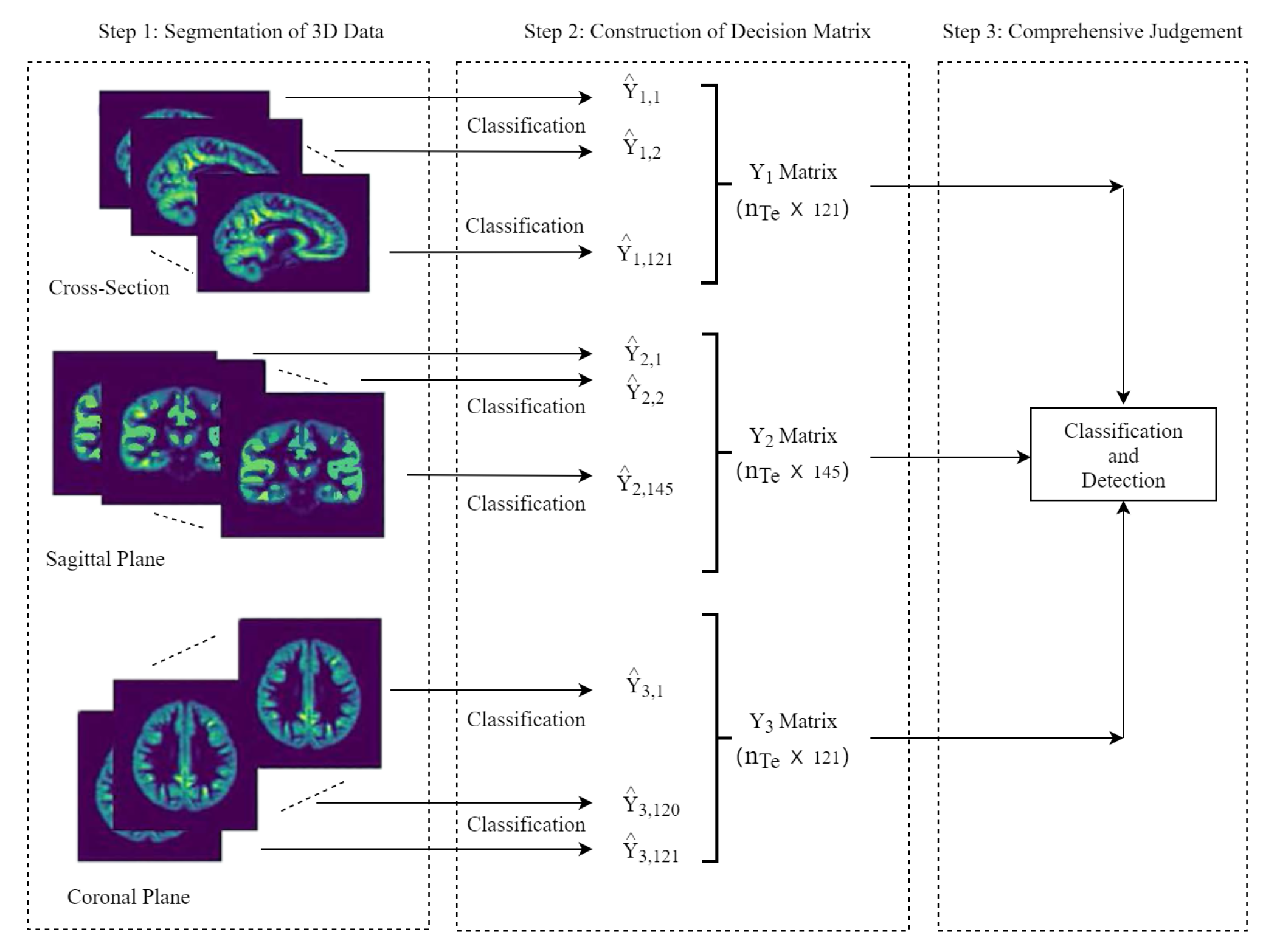Localization and Diagnosis of Attention-Deficit/Hyperactivity Disorder
Abstract
1. Introduction
- (1)
- (2)
- (1)
- On the basis of the 3D structure of MRI data, a multi-dimensional slice segmental method was proposed to enlarge the number of sample size and deduce the dimension. By integrating the position information of each slice, the spatial information of the data can be obtained to identify lesion regions.
- (2)
- Slices were labeled to be a disorder if k adjacent slices were decided to be a disorder to improve the final accuracy of classification. The optimal k is 3.
- (3)
- Classification accuracy was improved up to 75.4% in the full datasets, and it also reached a high point (of 81.82%) within the existing methods on a single sub-data set for the Kennedy Krieger Institute (KKI). Two suspected disorder regions were also detected, one of which perfectly matched the region found by Li et al. [16], and another suspected region was found at the first time.
2. Material
3. Methods
3.1. Segmentation of the 3D-MRI Sample
3.2. Classification of 2D Slices Based on Random Forests
- Step 1:
- Randomly select sub-samples from training samples by sampling with replacement as a bootstrap sample for 700 iterations.
- Step 2:
- Train 700 decision trees by using different bootstrap samples.
- Step 3:
- Make a classification for testing samples by using well-trained decision trees and exploit a majority vote on the classification results.
3.3. Diagnosis and Localization on Testing Sample
4. Results
4.1. Selection of Threshold k
4.2. Diagnosis Based on Classification
- (1)
- The first two methods take into account the heterogeneity between the datasets, and the search process is based on the sub-datasets NY and KKI.Social Network [9] utilized social network to extract the features of the ADHD-200 resting state function MRI (fMRI) data, and the classification is implemented by support vector machine classifier.Multi-Level [13] exploited a decision-trees-based multi-level approach, where the decision tree was constructed upon a subset of significant features.
- (2)
- The second type of research method is entirely based on the whole ADHD-200 dataset.FV + Demo [20] developed a support vector machine model to classify ADHD patients from typically developing controls (TDCs) using the regional brain volumes as predictors. The classifier utilized the highlighted 10 brain regions most distinguished in discriminating between ADHD patients and TDCs.In Reg-Tucker [16], the original data was decomposed by the tucker method first, and then the decomposed features were classified and reconstructed by the tensor regression method.Tensor LogitBoost [21] used the same feature extraction method as [16], it alternatively used Logit Boost algorithm in the classification procedure, which achieved better classification results compared with Li’s idea [16].3D-CNN [7] extracted a meaningful 3D low-level feature from function MRI (fMRI) and structural MRI (sMRI) data, and then used a multi-modality CNN architecture to combine fMRI and sMRI features. Since this method kept the low-level features as three-order tensors, the spatial information of the data was well preserved.
5. Discussion
6. Conclusions
Author Contributions
Funding
Institutional Review Board Statement
Informed Consent Statement
Data Availability Statement
Acknowledgments
Conflicts of Interest
References
- Bishop, H.J.; Boe, L.; Stavrinos, D.; Mirman, J.H. Driving among Adolescents with Autism Spectrum Disorder and Attention-Deficit Hyperactivity Disorder. Safety 2018, 4, 40. [Google Scholar] [CrossRef]
- Assari, S.; Caldwell, C.H. Family Income at Birth and Risk of Attention Deficit Hyperactivity Disorder at Age 15: Racial Differences. Children 2019, 6, 10. [Google Scholar] [CrossRef] [PubMed]
- Koji, S.; Yamada, K. Machine learning studies on major brain disorders: 5-year trends of 2014–2018. Jpn. J. Radiol. 2019, 37, 34–72. [Google Scholar]
- Lella, E.; Vessio, G. Ensembling complex network ‘perspectives’ for mild cognitive impairment detection with artificial neural networks. Pattern Recognit. Lett. 2020, 136, 168–174. [Google Scholar] [CrossRef]
- Lanka, P.; Rangaprakash, D.; Dretsch, M.; Katz, J.; Denney, T.; Deshpe, G. Supervised machine learning for diagnostic classification from large-scale neuroimaging datasets. Brain Imaging Behav. 2019, 15, 1–39. [Google Scholar] [CrossRef]
- Duffy, F.; Shankardass, A.; Mcanulty, G.; Als, H. A unique pattern of cortical connectivity characterizes patients with attention deficit disorders: A large electroencephalographic coherence study. BMC Med. 2017, 15, 51. [Google Scholar] [CrossRef]
- Liang, Z.; Zheng, J.; Miao, C.; Mckeown, M.; Wang, Z. 3D CNN Based Automatic Diagnosis of Attention Deficit Hyperactivity Disorder Using Functional and Structural MRI. IEEE Access 2017, 5, 23626–23636. [Google Scholar]
- Zhou, H.; Li, L.; Zhu, H. Tensor Regression with Applications in Neuroimaging Data Analysis. J. Am. Stat. Assoc. 2013, 108, 540–552. [Google Scholar] [CrossRef] [PubMed]
- Guo, X.J.; He, L.H. ADHD-200 Classification Based on Social Network. Int. Conf. Cloud Comput. Big Data 2014, 14, 55–61. [Google Scholar]
- Mei, Y.; Tan, G.Z. An improved brain emotional learning algorithm for accurate and efficient data analysis. J. Cent. South Univ. 2018, 25, 1084–1098. [Google Scholar] [CrossRef]
- Craddock, R.; Bellec, P.; Margules, D.; Nichols, B. 2015 Brainhack Proceedings. GigaScience 2016, 5, 1–26. [Google Scholar] [CrossRef]
- Soros, P.; Hoxhaj, E.; Borel, P.; Sadohara, C.; Feige, B.; Matthies, S.; Muller, H.; Bachmann, K.; Schulze, M.; Philipsen, A. Hyperactivity/restlessness is associated with increased functional connectivity in adults with ADHD: A dimensional analysis of resting state fMRI. BMC Psychiatry 2019, 19, 43. [Google Scholar] [CrossRef] [PubMed]
- Itani, S.; Lecron, F.; Fortemps, P. A Multi-level Classification Framework for Multi-site Medical Data: Application to the ADHD-200 Collection. Expert Syst. Appl. 2017, 91, 36–45. [Google Scholar] [CrossRef]
- Huang, L.; Goldsmith, J.; Reiss, P.; Reich, D.; Crainiceanu, C. Bayesian scalar-on-image regression with application to association between intracranial DTI and cognitive outcomes. NeuroImage 2013, 83, 210–223. [Google Scholar] [CrossRef]
- Goldsmith, J.; Huang, L.; Crainiceanu, C. Smooth Scalar-on-Image Regression via Spatial Bayesian Variable Selection. J. Comput. Graph. Stat. 2014, 23, 46–64. [Google Scholar] [CrossRef] [PubMed]
- Li, X.; Xu, D.; Zhou, H.; Li, L. Tucker Tensor Regression and Neuroimaging Analysis. Stat. Biosci. 2018, 10, 520–545. [Google Scholar] [CrossRef]
- Sachnev, V.; Suresh, S.; Sundararajan, N.; Mahan, B.; Azeem, M.; Saraswathi, S. Multi-Region Risk-Sensitive Cognitive Ensembler for Accurate Detection of Attention-Deficit/Hyperactivity Disorder. Cogn. Comput. 2019, 11, 545–559. [Google Scholar] [CrossRef]
- Craddock, R.; Tungaraza, R.; Milham, M. Connectomics and new approaches for analyzing human brain functional connectivity. GigaScience 2015, 4, 13. [Google Scholar] [CrossRef]
- Dou, Q.; Chen, H.; Yu, L.; Zhao, L.; Qin, J.; Wang, D.; Heng, P.A. Automatic Detection of Cerebral Microbleeds From MR Images via 3D Convolutional Neural Networks. IEEE Trans. Med Imaging 2016, 35, 1182–1195. [Google Scholar] [CrossRef]
- Tan, L.; Guo, X.; Ren, S.; Epstein, J.; Lu, L. A Computational Model for the Automatic Diagnosis of Attention Deficit Hyperactivity Disorder Based on Functional Brain Volume. Front. Comput. Neurosci. 2017, 11, 75. [Google Scholar] [CrossRef]
- Zhang, B.; Zhou, H.; Wang, L.; Sung, C. Classification based on neuroimaging data by tensor boosting. Int. Jt. Conf. Neural Netw. 2017, 1174–1179. [Google Scholar] [CrossRef]





| k | 2 | 3 | 4 | 5 |
|---|---|---|---|---|
| ACC | 0.743 | 0.754 | 0.695 | 0.678 |
| (a) | ||
|---|---|---|
| Method | NYU(41) | KKI(11) |
| Social Network [9] | 63.75% | 78.21% |
| Multi-Level [13] | 58% | - |
| 3D-CNN [7] | 70.5% | 72.82% |
| Proposed Method | 70.73% | 81.82% |
| (b) | ||
| Method | ADHD-200(171) | |
| FV + Demo [20] | 68.6% | |
| Reg-Tucker [16] | 68% | |
| Tensor LogitBoost [21] | 69% | |
| 3D-CNN [7] | 69.15% | |
| Proposed Method | 75.44% | |
Publisher’s Note: MDPI stays neutral with regard to jurisdictional claims in published maps and institutional affiliations. |
© 2021 by the authors. Licensee MDPI, Basel, Switzerland. This article is an open access article distributed under the terms and conditions of the Creative Commons Attribution (CC BY) license (http://creativecommons.org/licenses/by/4.0/).
Share and Cite
Wang, P.; Zhao, X.; Zhong, J.; Zhou, Y. Localization and Diagnosis of Attention-Deficit/Hyperactivity Disorder. Healthcare 2021, 9, 372. https://doi.org/10.3390/healthcare9040372
Wang P, Zhao X, Zhong J, Zhou Y. Localization and Diagnosis of Attention-Deficit/Hyperactivity Disorder. Healthcare. 2021; 9(4):372. https://doi.org/10.3390/healthcare9040372
Chicago/Turabian StyleWang, Peng, Xuejing Zhao, Jitao Zhong, and Ying Zhou. 2021. "Localization and Diagnosis of Attention-Deficit/Hyperactivity Disorder" Healthcare 9, no. 4: 372. https://doi.org/10.3390/healthcare9040372
APA StyleWang, P., Zhao, X., Zhong, J., & Zhou, Y. (2021). Localization and Diagnosis of Attention-Deficit/Hyperactivity Disorder. Healthcare, 9(4), 372. https://doi.org/10.3390/healthcare9040372






